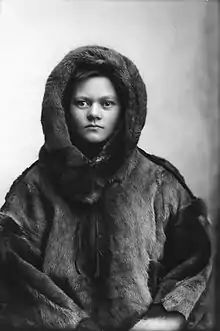Marie Høeg | |
|---|---|
 Høeg wearing fur coat | |
| Born | 15 April 1866 |
| Died | 22 February 1949 (aged 82) |
| Nationality | Norwegian |
| Known for | Photography |
Marie Høeg (15 April 1866 – 22 February 1949) was a Norwegian photographer and suffragist.[1] Høeg's published work was traditional in nature, while her private photography, including images of and created with her partner, Bolette Berg, challenged ideas of gender.[1] She was the founder of the Horten Discussion Association, which is still active today.[2][3] Høeg also started the Horten Branch of the National Association for Women's Right to Vote, the Horten Women's Council and the Horten Tuberculosis Association.[4]
Biography
Høeg was born in Langesund on 15 April 1866.[2] She was a photography student in Brevik and completed her photography apprenticeship in 1890.
From 1890 to 1895, Høeg lived in Finland, working as a photographer in Ekenäs and Hanko.[2] Here, she was greatly influenced by the Finnish women's rights movement.[5]
Høeg moved from Finland to Horten in 1895 together with Bolette Berg. Berg was five years younger than Høeg and had trained as a photographer, probably while living in Finland.[2][6] Høeg and Berg set up and ran their own photography studio,[7] which was named Berg & Høeg.[2] Høeg used their studio not only for photography, but also as a meeting place for women interested in feminism and women's suffrage.[2]

Høeg and Berg moved to Kristiania (present-day Oslo) in 1903 and continued working as professional photographers there, mostly producing scenic and portrait post cards.[6][8]
The two founded the publishing company Berg og Høghs Kunstforlag A.S., publishing books such as the three-volume Norske Kvinder, which concerns the topic of the history of Norwegian women.
Marie Høeg died in Oslo on 22 February 1949.[2]
Many of her glass negatives were discovered after her death inside a barn in the 1980s.[9] The barn was on the property of a farm where Berg and Høeg lived at the end of their lives.[9] A series of negatives in a box labelled "private" contained photographs of Berg and Høeg dressed in men's clothes, smoking, and wearing mustaches. These 440 glass negatives are now in the collection of the Preus Museum.[4]
References
- 1 2 "Marie Høeg Meets Klara Lidén". ONE Archives at the USC Libraries. University of Southern California. 2014. Retrieved 9 May 2016.
- 1 2 3 4 5 6 7 Moksnes, Aslaug. "Marie Høeg". Norsk biografisk leksikon (in Norwegian). Retrieved 9 May 2016.
- ↑ "Velkommen til Hortens Diskusjonsforening!". Hortens Diskusjonsforening (in Norwegian). Retrieved 9 May 2016.
- 1 2 "Bolette Berg (1872-1944) and Marie Høeg (1866-1949)". Preus Museum. Retrieved 9 May 2016.
- ↑ Baggethun 1974, p. 42
- 1 2 Bonge 1980, pp. 58, 185
- ↑ Breen, Marta (22 October 2008). "De første fotofeministene". Dagbladet Kunst (in Norwegian). Retrieved 9 May 2016.
- ↑ "The 'private' photographs of Marie Høeg and Bolette Berg: Questioning gender roles circa 1900". DangerousMinds. 2017-02-27. Retrieved 2017-06-14.
- 1 2 Eler, Alicia (11 April 2014). "An Androgynous Suffragette Portrait, Rediscovered". Hyperallergic. Retrieved 9 May 2016.
Further reading
- Baggethun, Rolf (1974). Speilet som husket: de første fotografer i Horten (in Norwegian). Horten: Preus fotohistoriske samling.
- Bonge, Susanne (1980). Eldre norske fotografer: fotografer og amatørfotografer i Norge frem til 1920 (in Norwegian). Bergen: University Library of Bergen. ISBN 8271300148.
External links
- "The 'Private' Photos of Marie Høeg and Bolette Berg: Questioning Gender Roles Circa 1900," Dangerous Minds (27 February 2017). Contains a gallery of Høeg's photographs.
- "Bolette Berg (1872-1944) and Marie Høeg (1866-1949)," Preus Museum website.
- Speech by Høeg (in Norwegian, 1901)